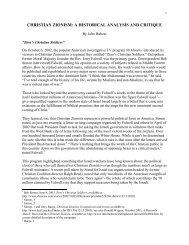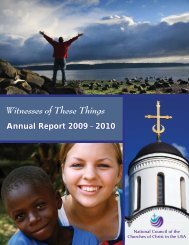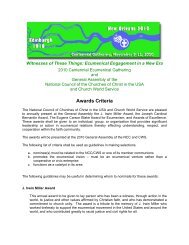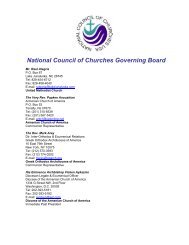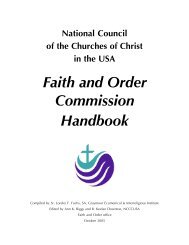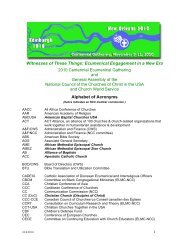Common Agreement on Mutual Recognition of Baptism - National ...
Common Agreement on Mutual Recognition of Baptism - National ...
Common Agreement on Mutual Recognition of Baptism - National ...
Create successful ePaper yourself
Turn your PDF publications into a flip-book with our unique Google optimized e-Paper software.
722<br />
723<br />
724<br />
725<br />
726<br />
727<br />
728<br />
729<br />
730<br />
731<br />
732<br />
733<br />
734<br />
735<br />
736<br />
737<br />
738<br />
739<br />
740<br />
741<br />
742<br />
743<br />
744<br />
745<br />
746<br />
747<br />
748<br />
749<br />
750<br />
751<br />
752<br />
753<br />
754<br />
755<br />
756<br />
757<br />
758<br />
759<br />
760<br />
761<br />
762<br />
763<br />
764<br />
some c<strong>on</strong>tinuity with either the ritual washing or mikvah <strong>of</strong> sec<strong>on</strong>d temple Judaism, Jewish<br />
proselyte baptism as used from at least the first century B.C.E., or the more isolati<strong>on</strong>ist Essenestyle<br />
baptism which was eschatological in character (cf. Serekh ha-Yahad or ―Community Rule<br />
Scroll‖). However, it was John himself who would presage the baptism <strong>of</strong> Jesus by<br />
distinguishing his own as merely a ―water‖ baptism versus the ―spirit‖ or ―fire‖ baptism to be<br />
given by the promised <strong>on</strong>e (Mt. 3.11 and Lk.3.16; Jn.1.33). Jesus would then use the term<br />
―baptism‖ to describe either a sharing in his sufferings for those who would follow him (cf. Mt.<br />
20.22-23 and Mk. 10.38) or as a name for his own rite <strong>of</strong> washing with water, but <strong>of</strong>fered by his<br />
disciples (Jn.4.1-2) at first <strong>on</strong>ly to Jews. Later, the apostles would adapt John‘s practices to the<br />
injuncti<strong>on</strong>s <strong>of</strong> Jesus to baptize gentiles as well (cf. Matt. 28. 19-20), with Paul then developing<br />
the term typologically by c<strong>on</strong>trasting the Israelites‘ ―baptism into Moses‖ (1 Cor. 10.2) over and<br />
against baptism into Christ Jesus. In sum, New Testament accounts provide several c<strong>on</strong>trolling<br />
images for baptism, with two <strong>of</strong> these particularly important in the patristic era, <strong>on</strong>ly to reemerge<br />
as central themes in recent reforms <strong>of</strong> baptism: (1) baptism as new birth through water<br />
and the Spirit (John 3) and (2) baptism as uni<strong>on</strong> with Christ in his death and resurrecti<strong>on</strong><br />
(Romans 6).<br />
New Testament texts are ambiguous about whether baptism was extended <strong>on</strong>ly to adults,<br />
or may have included children, as well. When Paul and others are said to have baptized an entire<br />
―household‖ (oikos), there is no doubt that it included men and women, married and widowed,<br />
and those who were free (cf. 1 Cor.1.16; Acts 16.15;11.14;16.31). But did it also embrace slaves<br />
and children ? Early Church figures such as Tertullian (c.160-c.240 C.E.) (cf. De spect. 4; De<br />
cor<strong>on</strong>a mulites 3; De anima 35) speak warmly <strong>of</strong> the baptism <strong>of</strong> children, but there seems to be<br />
no clear answer to the questi<strong>on</strong> <strong>of</strong> a universal understanding about the matter in the immediately<br />
sub-apostolic period. The probability <strong>of</strong> other mixed practices in the performance <strong>of</strong> baptism are<br />
also suggested in the New Testament. While it is clear, for example, that the Lord‘s injuncti<strong>on</strong> at<br />
Mt. 28. 19-20 involves a declarative formula for baptism, it is equally clear in Acts. 2.38, 8.16,<br />
10.48 and 19.5 that ―baptism in the name <strong>of</strong> the Lord Jesus‖ was comm<strong>on</strong>place in many early<br />
Jewish-Christian communities 11 . The same practice is found in the baptismal secti<strong>on</strong>s <strong>of</strong> the<br />
Didache 9.5 (c. 60 C.E.), where Christian praxis would emerge slowly from its home in apostolic<br />
Judaism.<br />
In the sec<strong>on</strong>d and third centuries, sources reveal varying patterns <strong>of</strong> development in<br />
baptismal practices. Justin Martyr‘s (100-165 C.E.) account <strong>of</strong> baptism in Rome, found in his<br />
First Apology (61, 65), describes a water baptism whose language is built around Eastern<br />
Christian noti<strong>on</strong>s <strong>of</strong> illuminati<strong>on</strong>.<br />
In Syria (Didascalia apostolorum,9.12) (c.250 C.E.?), there was str<strong>on</strong>g emphasis <strong>on</strong> prebaptismal<br />
anointing associated with the assimilati<strong>on</strong> <strong>of</strong> the baptized into the royal and priestly<br />
<strong>of</strong>fices <strong>of</strong> Christ. The baptism itself was accompanied by the Trinitarian formula and led directly<br />
to Eucharist. In North Africa, Tertullian (c.160-c.240 C.E.) described a process that included<br />
vigils and fasts, renunciati<strong>on</strong> <strong>of</strong> Satan, threefold creedal pr<strong>of</strong>essi<strong>on</strong> <strong>of</strong> faith at baptism, postbaptismal<br />
anointing, prayer with laying <strong>on</strong> <strong>of</strong> hands associated with the gift <strong>of</strong> the Spirit, and<br />
participati<strong>on</strong> in the eucharist (see De spect. 4; De cor<strong>on</strong>a mulites 3; De anima 35) . The<br />
c<strong>on</strong>tested Apostolic Traditi<strong>on</strong>, 21 (attributed to Hippolytus <strong>of</strong> Rome, ca. 215 C.E.) describes<br />
three years <strong>of</strong> catechesis, including prayer, fasting, and exorcism, and a formal rite <strong>of</strong> admissi<strong>on</strong><br />
11 Though this term may have been the comm<strong>on</strong> expressi<strong>on</strong> for a fuller ritual expressi<strong>on</strong> <strong>of</strong> baptism (cf. fractio<br />
panis).<br />
18



